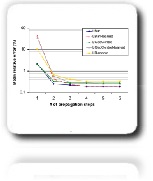Characterization of 3D fibrous media with geodesic methods

References
Vincent Morard,
Etienne Decencière,
Petr Dokladal
Centre de Morphologie Mathématique
Mathématiques et Systèmes, MINES ParisTech;
35, rue Saint-Honoré, 77305 Fontainebleau CEDEX - France
Abstract
We describe a study on the characterization of 3-dimensional (3D) fibrous structures from biological tissues images. The layout of the fibers, their size and shape are closely correlated with the deterioration of the tissue. These tissues have been manually classified into two main categories, {healthy, pathological} (See figure 1). Furthermore, each class has been divided into two groups, which leads to four class labels: {H0, H30, P70, P100}. The index of these labels corresponds to the deterioration rate of the tissue (0 stands for completely healthy and 100 for highly pathological).
We use some morphological operators to find features correlated with the deterioration of the tissue. We start from operators based on the geodesic diameter [3]. These operators are useful to characterize the length, the elongation and the tortuosity of the fibers. We introduce a new morphological tool, which is a thinning based on geodesic attributes [4]. We notice that the computation of the geodesic diameter is time consuming. Hence, we come up with a new geodesic attribute called the barycentric diameter. We also present further optimization and acceleration to obtain an efficient implementation.
Then, we use thinning operators in order to build skeletons [1]. We compute some statistics on the skeleton's branches after a pruning step and the suppression of the triple points. These features are useful to get complementary information on the spatial organization of the fibers.
With these features and the class ground truth of each 3D image, we use a machine learning strategy to build a model to classify each sample. A sparse representation is searched to avoid overfitting and to build the underlying model [2].
Table 1 is a description of the features used in this study and table 2 collects the prediction rate for some statistical models. The features are also sorted by order of importance and we notice that the mean length of the branches of the skeleton and the geodesic elongation of the fibers have a preponderant role in the prediction. This gives some crucial information on the fibers' evolution and their underlying structures.
Paper

Presentation

Conference information
3D Microstructure Meeting, (3DMM), November, 2011, Saarbrucken, Germany






